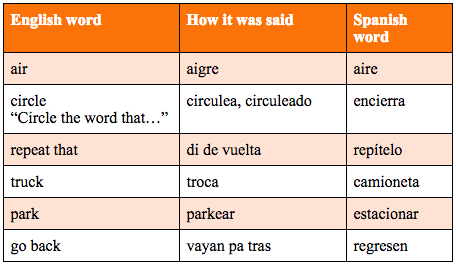Should teachers in bilingual or dual programs try their best to speak correct Spanish?
Let me elaborate. Constantly, I am faced with different words that are being spoken incorrectly or referred to as slangs. Most of the times the slang expressions are not from Mexico but from the Texas region. There is a mix of Spanish and English, modification, and a mixture of words. Some of these words are commonly used now in some areas, especially in Texas. If we look back on history, we can see that this is not the first time something like this has happened. When the Spanish conquered Mexico they brought the Spanish language. As the years went by, Mexico made their own version of Spanish. Today, if you visit both Spain and Mexico, you would realize that even though both countries speak Spanish, there are considerable differences. In Mexico, we recognize that our language is a different version of Spanish, Castellano, than that used in Spain. In Mexico, from the time children begin to learn Spanish, they are taught about other forms of speech that we do not use in Mexico's more simplified version of Spanish. They are taught that it is also proper but not the way we speak it in Mexico. When the Spaniards came to Mexico a new version of Spanish developed just as may be happening in the U.S., but it is the same teachers and educators that must decide what will be used and not used. Language is adapting all the time with new words and phrases, but just like English, only generally accepted terms finally become part of the language. The way things are happening with the massive variety of words used in "Spanglish" is that we are developing more confusion and making more difficult the integration and education of dual language. A teacher can't pick up just any word and decide it is useful to teach to their students. In Oaxaca, there are 155 dialects and languages spoken. The Zapotec people having been once a strong nation has been reduced to 100s or thousands of poor villages speaking at least 35 different dialects in just the state of Oaxaca and generally unable to communicate with each other. Most of this happened within a few generations. While their education system was not as formal as today, tribal leaders defaulted to allowing their way of saying things to become more important than having a common language. Coming back to Texas; I believe this is the beginning of what could be a “different” language. This might be exaggerating, but if teachers are actually using these “new” terms, the students are going to use them too, and pass them on. I decided to take one day and write some of the words and expressions I heard. Here are some of them:

I also repeatedly heard someone saying “so” in the middle of sentences when speaking Spanish and when speaking English, I heard them use the word “pero” a lot also. I was born and raised in Saltillo, Mexico. That is only 4 hours form the border, so it is really not far away and there is a noticeable difference in how people speak in that amount of distance. In my family, it has always been important to try our best to speak correctly, which brings me to question. Do you think we should be worried about how we teach Spanish? Should teachers in bilingual or dual programs be compelled to speak correct Spanish?